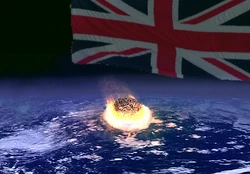| This The British Ain't Coming page is obsolete.
|
| |||||||
| Anthem | "Ceylon Matha" | ||||||
| Capital (and largest city) |
Colombo | ||||||
| Other cities | Galle, Kandy, Jaffna | ||||||
| Language official |
Sinhalese, Tamil | ||||||
| others | Dutch (recognized) | ||||||
| Demonym | Ceylonese | ||||||
| Government | Unitary semi-presidential constitutional republic | ||||||
| President | Maithripala Sirisena | ||||||
| Prime Minister | Ranil Wickremesinghe | ||||||
| Population | 20.28 million | ||||||
| Established | 1640 | ||||||
| Independence | from Republic of the Netherlands | ||||||
| declared | 1945 | ||||||
| recognized | 1949 | ||||||
| Currency | Ceylonese guilder (ƒ) (CYG)
| ||||||
| Time Zone | (UTC+4:30) | ||||||
| Internet TLD | .ce | ||||||
The Republic of Ceylon, or just Ceylon, is an insular sovereign state located in the Indian subcontinent of Asia. Ceylon is a unitary state that shares no land borders. Its closest neighbors are India to the north and the Maldives to the west.
Etymology[]
Ceilão, the name given to the island by the Portuguese when they arrived in 1505, is transliterated into English as Ceylon. This name was in use for the island as a Portuguese colony, a Dutch colony, and up to today as an independent nation.
Ceylon is known in Sinhalese as Laṃkā (Sinhalese: ලංකා) and in Tamil as Ilaṅkai (Tamil: இலங்கை). This name is transliterated into English as "Lanka," which is Ceylon's name in Hindu mythology. Lanka is sometimes used in conjunction with Ceylon, although Ceylon remains the official name of the nation.
History[]
Prehistory[]
The prehistory of Ceylon goes back 125,000 years and possibly even as far back as 500,000 years. The era spans the Paleolithic, Mesolithic and early Iron Ages. Among the Paleolithic human settlements discovered in Ceylon, Pahiyangala, Batadombalena, and Belilena are the most important.
One of the first written references to the island is found in the Indian epic Ramayana, which provides details of a kingdom named Lanka that was created by the divine sculptor Vishwakarma for Kubera, the Lord of Wealth.
Early inhabitants of Ceylon were probably ancestors of the Vedda people, an indigenous people numbering approximately 2,500 living in modern-day Ceylon.
Pre-Anuradhapura period[]
According to the Mahāvamsa, a chronicle written in Pāḷi, the original inhabitants of Ceylon are the Yakshas and Nagas. Sinhalese history traditionally starts in 543 BCE with the arrival of Prince Vijaya, a semi-legendary prince who sailed with 700 followers to Ceylon, after being expelled from the Vanga Kingdom (present-day Bengal). He established the Kingdom of Tambapanni, near modern-day Mannar. Vijaya (Singha) is the first of the approximately 189 native monarchs of Sri Lanka described in chronicles such as the Dipavamsa, Mahāvaṃsa, Cūḷavaṃsa, and Rājāvaliya. Ceylonese dynastic history ended in 1802 CE, when the island was unified under the Dutch Empire.
| ||||||||||||||||||||||||





